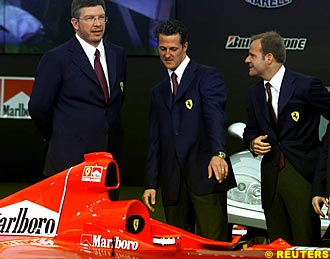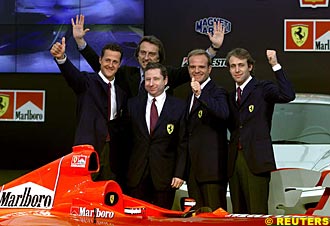Monday February 7th, 2000
Read the Interview with Ferrari's designer, Rory Bryne
Read the Interview with Ferrari Engine Chief, Paolo Martinelli
Interview with Ferrari's technical director, Ross Brawn
Q: Isn't it a risk that you're launching your new car so late in the season?
 Ross Brawn: I don't think it was too much of a risk, but there were one or two things that Rory was working on and we decided that we wanted them for the start of the season rather than wait until the start of the European season which would have been the case. So we made the decision to push and try and finish those things which put a bit of time on the car. But I'm not too concerned because I think the timing to the first race is quite similar to last year. Aerodynamics was the main area.
Ross Brawn: I don't think it was too much of a risk, but there were one or two things that Rory was working on and we decided that we wanted them for the start of the season rather than wait until the start of the European season which would have been the case. So we made the decision to push and try and finish those things which put a bit of time on the car. But I'm not too concerned because I think the timing to the first race is quite similar to last year. Aerodynamics was the main area.
Q: What was the weakness at the start of the season last year?
Brawn: We had some things that we wanted to do at the start of the season and for various reasons we couldn't do them. We had an aerodynamic package for the rear end of the car but because we had problems with the crash test at the start of the season, we couldn't use it until later in the year. There were some things that we didn't have at the start of the season, but when they came along, they made the car much more competitive. The only thing I regret from last year is the competitiveness at the start of the season.
Q: Is there anything that you have done early on that makes you think that Ferrari might be on pole for the first race of the season?
Brawn: One of the things that we are quite strong at is developing the car so it's quite difficult from the end of one season to the beginning of the next to make a big step but I think if we judge our performance by the end of last year when we were on pole in Suzuka and to this car, we have made a big step between the end of last year and the beginning of this year. There's no reason at all why we shouldn't be competitive, but as we know, how much progress our competitors have made also makes a difference. That's something we can't control. But I know from the work that Rory has done on the car and Paolo has made on the engine, that we have made a good step forward.
Q: Has having your own wind tunnel changed a lot?
Brawn: It's a pretty impressive facility, very very good. At the moment we're testing 16 hours a day and we are working towards 24 hours a day. It's a very high quality facility - the correlation between car and model is excellent. It's a big step forward for us.
Q: Luca Badoer no longer has a full time drive, but you've kept him on as test driver. Why?
Brawn: He's an excellent test driver and he's contributed an awful lot to the competitiveness of the car so we're very glad he's stayed with us this year.
Q: Who are going to be your main rivals this year?
Brawn: I think McLaren will be the main competitor. Jordan have obviously made very good progress for the last few years, and they have a stable organisation, and a stable package in terms of engine and so forth. So I'm sure they will be strong and Trulli could be a surprise. So with two strong drivers they will be in a strong position. I also suspect Williams could have teething problems this year. Benetton are still rebuilding; it's difficult to judge how that will go. So I think Jordan and McLaren are going to be the serious competitors this season.
Q: What does it mean to have stability in the engineering departments?
Brawn: We're now in our fourth year together as a group since we re-organised the design group at Maranello and it's surprising how much improvement you see with each new car. Everyone is a bit more settled, everyone knows one another better, everyone knows their strengths and weakness, we know how to organise a group. We're been fortunate to keep a fairly stable group of engineers and designers together, but it still takes a few years.
Q: Are the new materials that you're using a bit of gamble?
Brawn: I don't think so. There's been a tremendous amount of work done in 1999 on the application of those materials so we're not trying them for the first time. In fact, we tested quite a lot of the pieces on last year's car. But materials are certainly an area where all teams have to do a lot of work, because we're chasing weight, we're trying to reduce the overall weight to run more ballast.
Q: Tell us about the advantages of this new car?
Rory Byrne: The 2000 Formula One car is the first to be conceived entirely in our new wind tunnel. It incorporates a fundamental revision of the placement of the main masses, including a new V10 engine, to optimise the weight distribution.
We have also incorporated a number of characteristics which will be obligatory for the coming years, to improve driver comfort and safety.
Q: So where has the main performance improvement come from?
Byrne: I think the main improvement in performance comes from the aerodynamics. In this area, we have made the biggest step forward since I joined Ferrari. I think part of the improvement is because we've done all the development in the new facility, rather than the old one, and it's due partly to the effort that the aerodynamic department has put into this car. It was started a lot earlier than last year's car and that's paid off.
The transmission is all new and incorporates new materials and processes. Its lubrication system has been revised to save weight and improve efficiency.
On the suspension side, we have a new system for the springs and the height adjustment and for the first time, all the main components are made from carbon composite. The power steering system has also been revised. We are using torsion bars with the suspension but the fundamentals of the suspension are different this year.
The fuel system has been completely redesigned to improve performance in both qualifying and the race, when it will be possible to reduce the time taken to refuel. In terms of fuel capacity, it's something we review from year to year and we've reviewed it for this year, but I'm not prepared to say what we've done.
In terms of the fuel flow, the FIA regulates the flow delivered at the nozzle but there are other areas where you can gain a small advantage if you're careful. You can certainly lose it if you're not careful.
There is a new Step 9 Marelli electronic system which improves the management and data acquisition system on the engine and car.
Q: Has regulation stability helped?
Byrne: The longer the regulations are stable, the more difficult it is to make big gains, so I'm quite pleased with the gains that we've made, bearing in mind this is the third year of similar type of regulation. There are always places to look for improvements, but it gets more difficult. You need to put in more effort, but I don't believe we'll ever come up against a brick wall, not with the current rules. There's still scope for development.
Q: You've tested on your own at your own test tracks for the past couple of years? Has that been a good or bad thing?
Byrne: Whether we test at Barcelona or Fiorano or Mugello I don't think is going to make very much difference on our first race competitiveness. We're going as hard as we can and we're going to be introducing updates and modifications during this test programme to give yourselves maximum competitiveness for Australia. Whether we test at Barcelona or Mugello will not actually test our performance. We feel it is much more important to be close to base so that we can attend to any problems much more quickly; the whole logistics is much easier.
Q: Are you running full scale models in the wind tunnel at the moment?
Byrne: We're mostly running a fifty per cent model in there at the moment, but there is provision to run a full scale model and we'll review that in due time. We have two models at the moment but we're constantly reviewing that and upgrading our facility and capability. That may increase in the future.
Interview with Ferrari's designer, Rory Bryne
 We have also achieved a significant reduction in the height of the centre of gravity. This helps tyre wear in a race. In '98, the overall width of the car was narrowed another 200mm and the narrower the regulations make the car, the more important it is to reduce the height of the centre of gravity. The effect on tyres is one of the most important aspects, but there are others such as reduced roll, improved aerodynamic efficiency. It's one of those areas where you lower it as much as you practically can.
We have also achieved a significant reduction in the height of the centre of gravity. This helps tyre wear in a race. In '98, the overall width of the car was narrowed another 200mm and the narrower the regulations make the car, the more important it is to reduce the height of the centre of gravity. The effect on tyres is one of the most important aspects, but there are others such as reduced roll, improved aerodynamic efficiency. It's one of those areas where you lower it as much as you practically can.